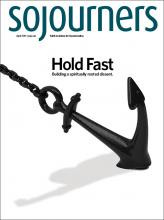ROBERT HARVEY had a problem. The church he pastors was vandalized after the election: “Trump Nation. Whites only” was scrawled across its sign. His congregants, nearly 85 percent of whom are immigrants from West Africa, Latin America, and the Caribbean, were shaken.
The Southern Poverty Law Center reported 1,094 bias-related incidents across the country in the month after the election. The greatest number of these types of events are against women in public spaces who are also immigrants, Muslim, or African American. These are assumed to be a “small fraction of hate-related incidents,” as the Bureau of Justice Statistics estimates that two-thirds of hate crimes go unreported.
Harvey, rector of Episcopal Church of Our Saviour in Silver Spring, Md., decided to take action. First, he reached out to the local community and other religious congregations. Second, he signed up for a nonviolence and “active bystander intervention” training.
To understand how to be an “active bystander,” one must first understand the “passive bystander” effect. Research shows that when someone needs help and they are in a crowd, bystanders are less likely to act. The more bystanders there are to an event, the more each one thinks someone else will help.
Read the Full Article

